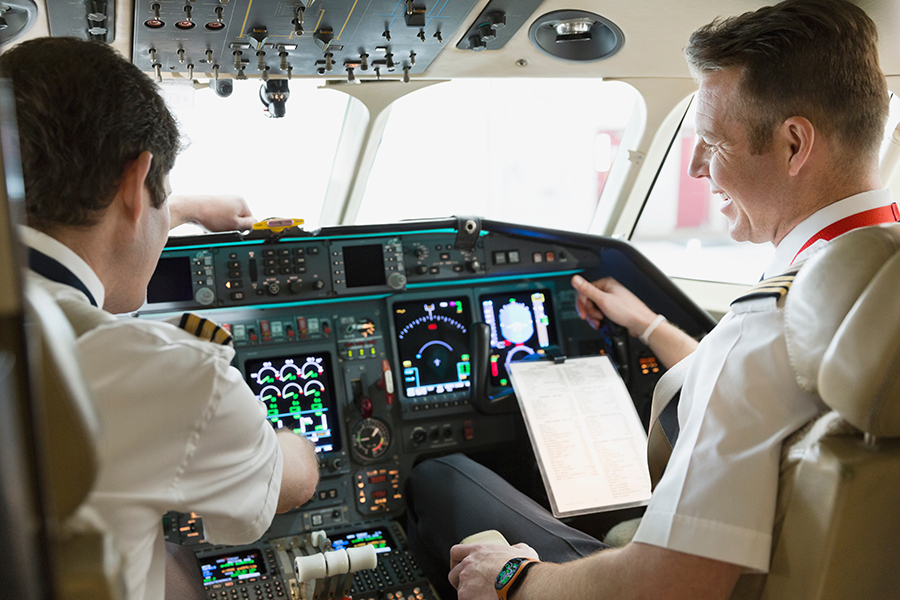-
Definition of a Flat Spin
- The Difference Between a Normal and Flat Spin
-
How to Recover from a Flat Spin
- PARE - The Spin Recovery Acronym
- P - Power
- A - Ailerons
- R - Rudder
- E - Elevator
-
What Can Cause a Flat Spin?
- Aft Center of Gravity (CG)
- Uncoordinated Flight
- Aggressive or Abrupt Maneuvering
-
How to Prevent a Flat Spin
- Proper Flight Training
- Stay within Aircraft Limitations
- Maintain Situational Awareness
-
Notable Accidents Involving Flat Spins
- 2006 Cessna 152 Crash
- 2000 Pitts 260DB Flat Spin Crash
- 2021 Cessna A150 Crash
-
Conclusion
A flat spin is a thrilling (and potentially dangerous) flight phenomenon that pilots must prepare for.
The heart-stopping scene in Top Gun, where Maverick and Goose find themselves in a deadly flat spin, isn’t unrealistic.
In this article, you’ll learn what a flat spin is and how to avoid it.
Ready to become a safer pilot?
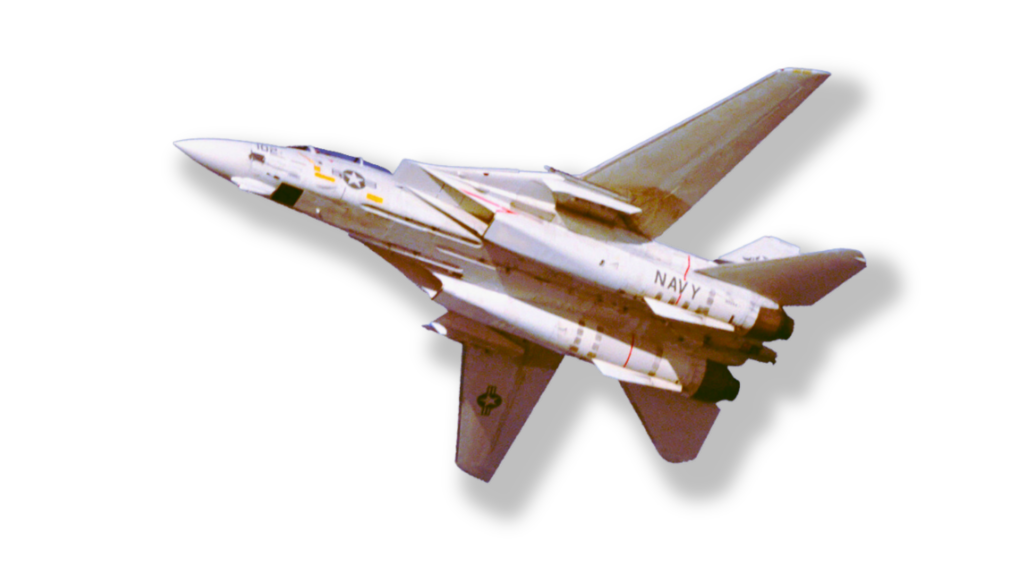
Definition of a Flat Spin
A flat spin is a dangerous and potentially life-threatening flight condition that occurs when an aircraft enters an uncontrolled spinning motion.
A flat spin happens when the center of gravity shifts too far aft (toward the tail), and the aircraft’s rotation becomes more horizontal. In this situation, the wings aren’t producing enough lift, and the aircraft essentially falls out of the sky while spinning.
Flat spins are particularly hazardous because the level attitude and reduced airflow over the control surfaces make it difficult to regain control of the airplane.
The Difference Between a Normal and Flat Spin
To understand flat spins, you need to understand how an aircraft stalls (and ultimately spins).
A stall occurs when the angle of attack (the angle between the wings and the airflow) becomes too high, causing the wings to lose lift. If a stall is accompanied by yaw (rotation around the vertical axis), it can lead to a spin, which is an autorotation around the aircraft’s center of gravity.

This yaw (spinning rotation) results from one wing producing more lift than the other. The initial rotation that initiates a spin may result from other factors, such as incorrect control inputs or turbulence.
Unlike a regular spin, where the airplane’s nose points downward, a flat spin occurs when the aircraft remains almost level with the horizon as it rotates.
Because of this level of attitude, very little air flows over the control surfaces, significantly reducing their effectiveness.
This lack of control effectiveness makes a flat spin particularly challenging (and sometimes impossible) to recover from.
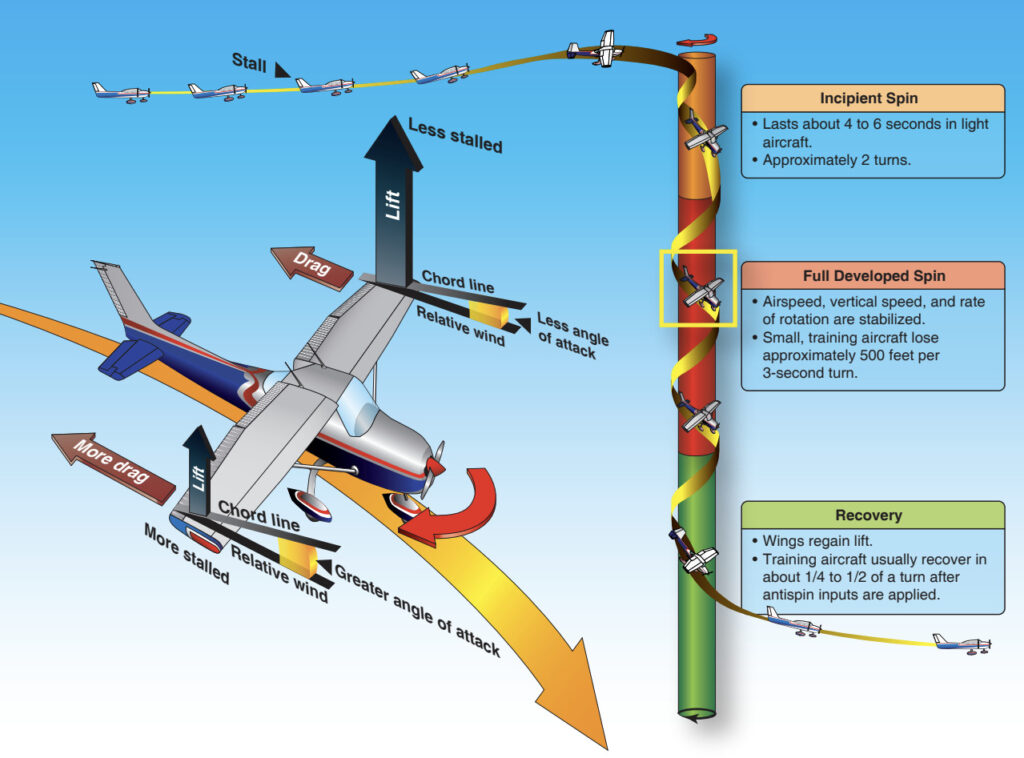
How to Recover from a Flat Spin
Getting out of a flat spin requires a specific technique consisting of certain actions executed in order.
The easiest way to remember the recovery actions required (and in what order to execute them) is to use the acronym PARE.
PARE – The Spin Recovery Acronym
PARE stands for:
- Power: Idle.
- Ailerons: Neutral.
- Rudder: Full opposite input to the spin direction.
- Elevator: Slightly forward.
Let’s explore and explain each aspect in detail.
P – Power
The first step in the spin recovery procedure is to reduce power to idle.
It may seem counterintuitive to reduce your power during a spin. After all, we’re in a stall, and the first step of a normal stall recovery is to increase power.
The problem is that the airflow from the propeller goes over the horizontal stabilizer, which produces a downward force (and causes the nose to pitch up).
If you increase power, this effect increases, and the nose wants to pitch up even further – the opposite of what we need to recover from a spin.
A – Ailerons
The second step in the spin recovery procedure is to move the ailerons to the neutral position.
Why?
The movement of the ailerons will change the angle of attack of both wings.
If you apply ailerons in the opposite direction of the spin, the spin will get worse. The downgoing aileron will increase the angle of attack and make the stall worse on that side while doing the opposite on the other – not good.
What if you apply ailerons in the direction of the spin? Won’t that allow you to recover from the spin?
The problem is, as soon as you start to recover, you’ll likely enter a spin in the opposite direction! You’ll bring the aircraft out of the spin only to create the conditions that made it enter in the first place.
R – Rudder
The third step in the spin recovery procedure is to apply the opposite rudder to the direction of the turn.
In other words, if you’re spinning to the left, apply the right rudder, and vice versa.
Once the spinning stops, make sure that you bring the rudder back to neutral. If you don’t, you risk entering a spin in the opposite direction.
E – Elevator
Finally, the fourth step in the spin recovery procedure is to push the yoke slightly forward.
If you’re in a normal spin (where your nose points down toward the ground), it may seem daunting to push forward on the yoke. But you need to reduce the angle of attack to get out of the stall.
What Can Cause a Flat Spin?
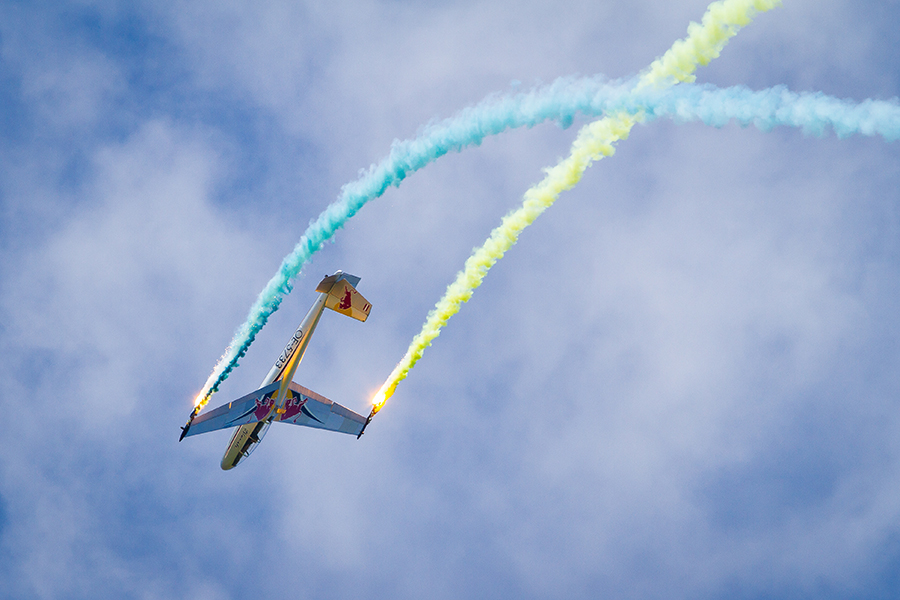
Understanding what causes a spin is the first step to avoiding it.
Several factors can cause a normal spin, but one primary factor usually leads to a flat spin: an aft center of gravity.
Aft Center of Gravity (CG)
A significant factor that can lead to a flat spin is having the center of gravity too far aft (toward the tail) of the aircraft. When the CG is in this position, it can make the aircraft more unstable and prone to entering a flat spin when stalled and uncoordinated.
Uncoordinated Flight
Like in a regular spin, uncoordinated flight plays a significant role in causing a flat spin. If the ailerons, rudder, and elevator are unbalanced during a stall, the aircraft could enter a flat spin due to the increased yaw and lack of control.
Aggressive or Abrupt Maneuvering
Attempting aggressive or abrupt maneuvers, especially with an aft CG, can lead to a flat spin. The combination of a high angle of attack and yaw can cause the aircraft to enter an uncontrolled, level, spinning motion.
How to Prevent a Flat Spin
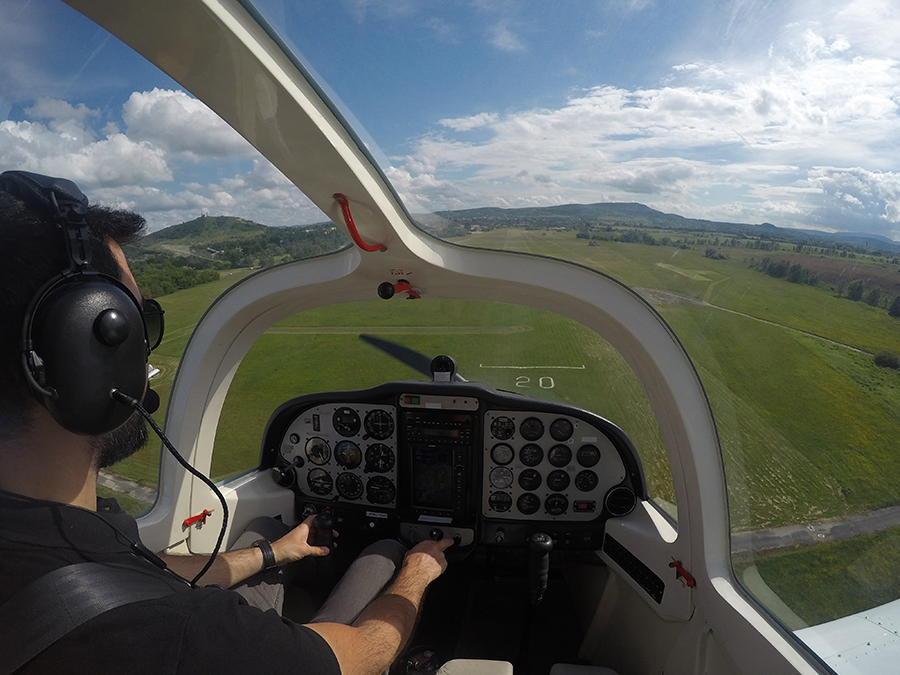
What’s the easiest way to recover from a spin? Don’t enter one!
Let’s explore how we can avoid unintentional spins.
Proper Flight Training
Proper flight training will save your life. The ability to identify an approaching stall and spin, and being able to recover effectively, is crucial.
Familiarize yourself with the warning signs of a stall, such as buffeting or reduced control responsiveness. Regularly practice stall recognition and recovery techniques (including spin recovery) with your flight instructor to prepare for such situations.
Stay within Aircraft Limitations
Understand your aircraft’s performance and limitations, including its stall speeds, critical angles of attack, and maneuvering speeds. Always operate within the specified limits to ensure safe flight conditions.
Furthermore, always ensure your aircraft’s weight and balance are within the specified limits. An aft CG makes the aircraft more prone to flat spins. Double-check your loading, fuel consumption, and passenger distribution to maintain a proper CG throughout your flight.
Be cautious with your control inputs when flying close to the stall speed or at high angles of attack. Do not attempt abrupt or aggressive maneuvers that can lead to a stall or uncoordinated flight, which may result in a spin.
Maintain Situational Awareness
Continuously assess and manage the risks associated with your flight. Stay vigilant about weather conditions, airspace restrictions, and other factors that could affect your flight’s safety.
Situations, where you are low and slow (such as during landing and takeoff), require greater situational awareness to avoid stalls and spins.
Notable Accidents Involving Flat Spins
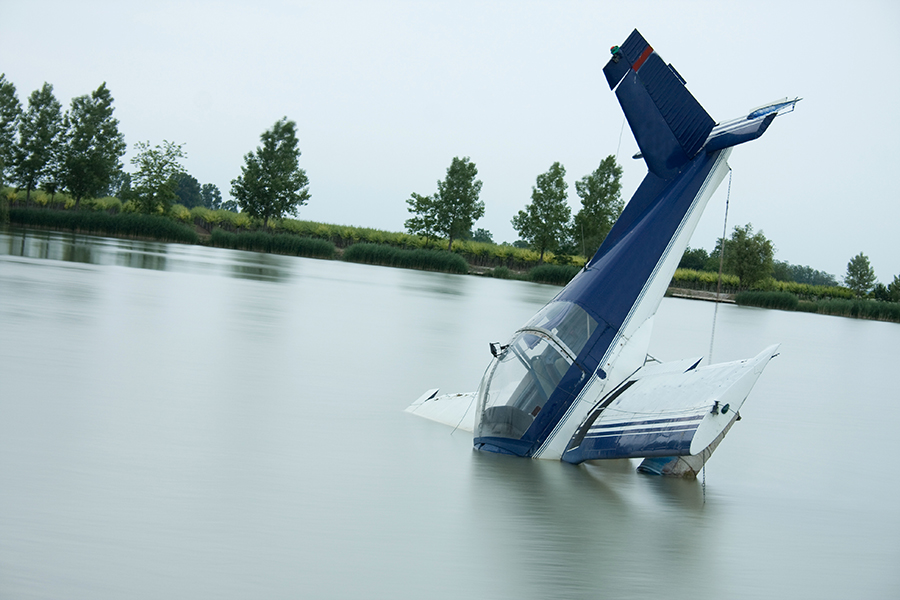
Flat spins have been responsible for several notable commercial and general aviation accidents.
These accidents serve as important lessons for pilots to understand the dangers of flat spins and emphasize the importance of proper training, risk management, and adherence to safety guidelines.
Here are three notable accidents involving spins.
2006 Cessna 152 Crash
On June 8, 2006, an instructor and student departed for a spin training flight in a Cessna 152.
The flight took place after a similar spin training flight, and there were no mechanical issues with the aircraft.
After entering an intentional spin, the aircraft never recovered, impacting the ground and killing both on board.
The investigation revealed that the student allegedly exhibited anxious responses in high-pressure scenarios, such as tightly grasping the yoke and resisting relinquishing control of the aircraft to instructors.
It is likely that a similar situation occurred preventing the CFI from executing the spin recovery procedure.
2000 Pitts 260DB Flat Spin Crash
In December 2000, a Pitts 260DB aircraft crashed in the Everglades after entering an unrecoverable flat spin at 3,500 feet.
The airplane was 120 pounds over its maximum acrobatic category weight, and its center of gravity was slightly aft of the rear limit, contributing to the spin. The pilot’s issues with hammerhead stalls, along with the rear-seat pilot’s weight, further contributed to the aft CG condition.
The excessive weight and aft CG position made spin recovery difficult. The pilots bailed out too late for their parachutes to open.
The NTSB concluded that there was no evidence of airframe, control system, or engine malfunction, attributing the accident to the airplane’s weight and CG position.
2021 Cessna A150 Crash
On 23 June 2021, a fatal aerobatics training flight accident occurred in Queensland, Australia, involving a Cessna A150 Aerobat.
The instructor and student were likely practicing two spin recovery methods, including the Meuller/Beggs method, which is not effective for a Cessna A150 Aerobat in a left spin.
The Meuller/Beggs spin recovery method is an alternative spin recovery method that involves releasing the controls, closing the power, and using an opposite rudder. Developed primarily for Pitts aircraft, the technique is far less effective in other airplanes.
The aircraft collided with bushland during the spin recovery, fatally injuring both occupants. The instructor was experienced with the Meuller/Beggs method in Pitts Special aircraft but likely had no experience in spinning a Cessna A150 Aerobat.
The investigators could not conclude if the use of an inappropriate recovery technique contributed to the accident.
A Safety Advisory Notice was issued to raise awareness about the limitations of the Mueller/Beggs spin recovery method among aerobatic pilots and instructors.
Conclusion
Always prioritize safety, continuous learning, and following established procedures to ensure a successful and rewarding flying career.
Understanding the causes of a flat spin, knowing how to prevent them, and learning proper recovery techniques are essential to becoming a safer pilot.
By arming yourself with knowledge and regularly practicing stall and spin recovery with your flight instructor, you can avoid the potentially disastrous consequences of a flat spin.
Safety always comes first in aviation, and thorough preparation is critical. So stay informed, stay within limits, and keep practicing to become the best pilot you can be.
And remember – PARE!



